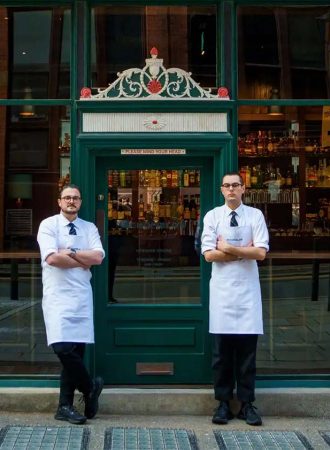At one time, the most theatre you could expect in a restaurant was a dessert trolley being rolled out, a crispy duck being grumpily shredded with a pair of spoons, or a bow-tied waiter setting fire to your crêpes at the tableside.
The latter, to be fair, was and is still pretty cool, and should make an immediate comeback.
Now it’s all foams being squirted on your pudding, glass cloches filled with smoke, things dissolving in your bowl, dry ice, liquid nitrogen and stuff being sprayed on your cocktails from an atomiser.
But in terms of sheer spectacle, there’s one dining experience in Manchester which stands out there on its own. In fact, we can assuredly say that there’s absolutely nothing else like it.

Last September, at the tail end of tuna season, chef patron Mike Shaw of Japanese restaurant MUSU procured a whole bluefin tuna, caught off the coast of Cornwall.
In the Japanese tradition – and being blessed with one or two rather skilled sushi chefs on staff – he decided to hold the restaurant’s first cutting event.
The idea – the huge beast (actually a relatively tiny specimen compared to many, but still weighing in at around 17 stone) is displayed on the restaurant’s sushi counter and broken down in front of diners, as Mike and his chefs talk you through every stage of how this creature came from the sea to where it is now.
This includes the fascinating provenance of the fish, the methods of fishing, and of its slaughter – always ‘iki jime’, the most humane method, done quickly and moments after catching – to ensure the least possible distress, but to also safeguard the quality of the final product.
It’s a real journey, one that is at times graphic, but entirely captivating nonetheless.

Some have become emotional during the ceremony, Mike says. If we choose to eat meat – and after witnessing this, the difference between meat and fish seems arbitrary – then we must confront where it comes from.
Last week, the creature being carved was a farmed fish, from off the coast of Malta.
As wild tuna is out of season for fishing (the season will run from June or July until September or October), the decision was made to source a fish from an ethically run firm with farms across the Mediterranean, where bluefin are raised in large enclosures, eating a natural diet of fresh herring, mackerel and sardines, just as they would in the wild.
All the information about the farm is projected onto screens around the restaurant, about how the tuna grows, how they are fed and at what weights they are harvested ‘at their pinnacle’.

Mike, who has spent almost his entire career working in Michelin-starred restaurants (starting aged 16 with Raymond Blanc at Le Manoir), has strict rules on where he sources his produce. MUSU is an ‘ingredients-led’ restaurant, he stresses. Nothing comes above that.
It’s where all that provenance comes in. “I don’t agree with salmon farms,” he says. “They’re horrendous places. These farms [where he sources his off-season bluefin], they’re vast.” Similarly, if he’s buying chicken for yakitori, they’ve spent their entire lives wandering the countryside, not crammed into lightless sheds.
The fish arrives in a huge ‘coffin’, and takes eight members of staff to carry it into the kitchen. When guests arrive, they have pictures taken with it.
Then, Mike and his sushi chef Andre Aguiar, who was trained by Japanese sushi master Yugo Kato, assisted by a phalanx of chefs from the kitchen, begin the precise business of carving.

‘Quarters’ are separated – there’s fatty meat from the belly, the cheek, the fillet-like loin, the powerfully flavoured bloodline, the prized cuts from the collar that more or less melt once they hit your tongue.
All the while, the process of carving is explained. It is an education, and with each cut of tuna removed, the guests are encouraged to come up and take a piece to eat.
The education continues, with Andre explaining how he learned his trade, spending a whole year simply cutting and prepping vegetables, and then another year washing and cooking rice.
His training culminated in finally being given his knife by his master and being allowed to handle and cut fish. It is a level of discipline that is hard to understand.
Once the carving is done, much of the fish is then frozen down at -60c to be used in the coming weeks. But the freshly cut sashimi soon arrives at the table; the akami from the upper back, the medium fatty chu-toro from the belly and the silken o-toro, the fattiest cut.

The same cuts then arrive on perfectly formed nigiri (topped with caviar), Mike explaining that getting the rice to that level of perfection is arguably more important than the tuna to Japanese sushi chefs. Their rice comes direct from Japan, and only MUSU and another three-star restaurant in London get hold of it.
The final course is a hosomaki roll, with some of that melting collar meat wrapped up with rice and a paper-thin sheet of seaweed. All this can, if you wish, be accompanied by a selection of curated sakes, put together by MUSU’s master sommelier Ivan Milchev.
So far, all the sessions have sold out in just a few hours. When the season starts again in the summer, he’ll be sourcing wild bluefin again from the sea. He hopes to find a fish that is three times the size of that carved the other evening. Which was no tiddler.
Now that would be a spectacle.
Tickets are £80, or £120 with a Sake pairing. You can book through the link below. If tickets are sold out you can join MUSU’s waitlist to be notified of the next date prior to general release.


